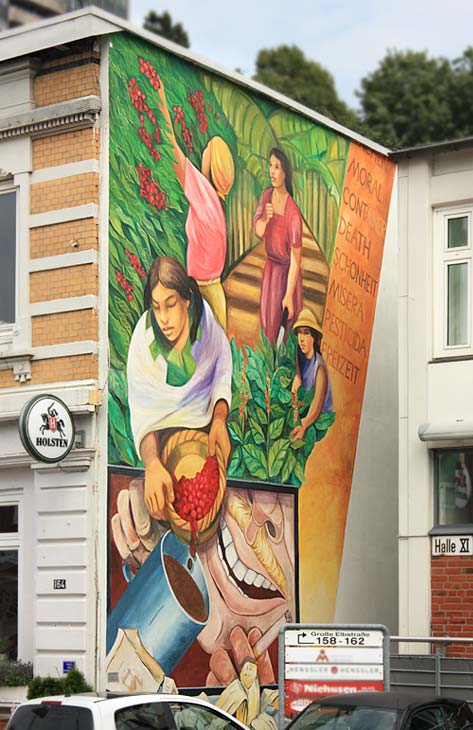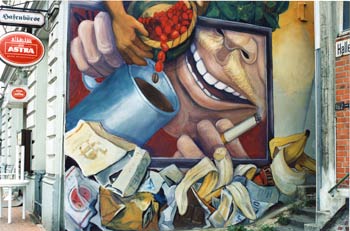Women harvesting coffee, tobacco and bananas, 1994

"Women harvesting coffee, tobacco and bananas"
Große Elbstraße 164, East wall.
Design and realisation: Cecilia Herrero, Janet Pavone, Hildegund Schuster.
Sponsors: R&S Baugesellschaft - Photo: johannes Kohl ©
The second mural in the Women’s Open Air Gallery is another artistic cooperation between Cecilia Herrero from Argentina, Janet Pavone from New York and Hildegund Schuster from Hamburg. It was painted just a few steps away from the first mural "Women in the fish industry" FrauenFreiluftGalerie Hamburg (The Women's Open Air Gallery) immediately after its completion. The mural's bright, warm colours are indicative of the tradition to which it belongs, with the two foreign artists having studied mural painting in Nicaragua. While painting the mural, they said: "We want to produce something that looks like a Nicaraguan picture. It shouldn't be purely decorative. In other words, we want to make a critical statement about the circumstances, rather than simply celebrate the status quo".
On the east side of the building which dates back to the 1890s, the mural is a striking eye-catcher that is clearly visible from far off. It shines a light on how work done by women helped to make Hamburg rich: in Latin America, bananas, coffee berries and tobacco were harvested by women and girls. These natural products went through women's hands before arriving in Hamburg. The Hanseatic city is Europe's main port for importing bananas and raw coffee, which are then processed or refined among others in the Speicherstadt.
The bright yellow word strip gives pause for thought, including PESTICIDA - (Spanish for pesticide), SCHÖNHEIT, (German for beauty), FREIHEIT (German for freedom), DEATH, CONTAINER, MORAL. The words all have some kind of association with the specific working conditions endured by women, men and children in the countries of origin. Relatively little is known here about these conditions. The dangers include for example the extreme health hazard posed by the large quantities of pesticides, herbicides, fungicides and insecticides used in conventional banana plantations. (1) Workers in the plantations are directly exposed to the effects of these toxic substances that also pollute the air and groundwater.
Another issue is the often extremely low wages paid to the banana workers due to price dumping and competition among multinational fruit corporations.

Consumption and civilisation waste
- Foto: Hildegund Schuster ©
Towards the base of the mural there is a picture-in-picture featuring an advertisement with a blond man consuming tobacco and coffee. A dark skinned woman symbolically pours him a mug of coffee from brown roasted beans. At the same time, she acts as the link from harvesting the red coffee berries to the consumer. The picture is a parody that makes fun of Western advertisements. It also criticises inequality and exploitation in the relationship between the producing countries in the poorer South and the consuming countries in the richer North. Aggressive pricing exacerbates the situation, with products sold purely to maximise profits without assuming any ethic responsibility towards people and the environment. Right down on street level, eye-to-eye with the garbage and sweepings, we find a strip with consumer refuse consisting of half-eaten bananas and cigarette packets that have been carelessly thrown away - a thought-provoking comment by the artists that also inverts Western clichés of rubbish damps in Southern countries.
© Elisabeth von Dücker, 2011

